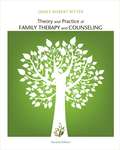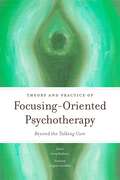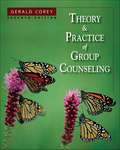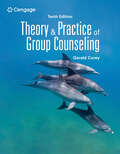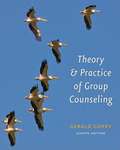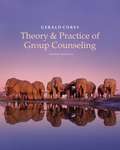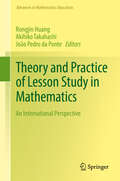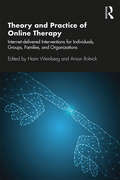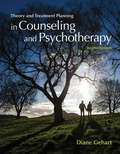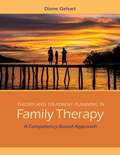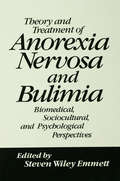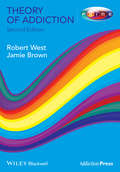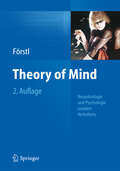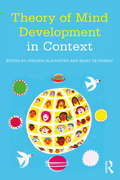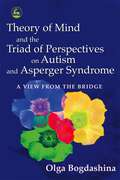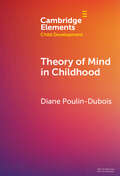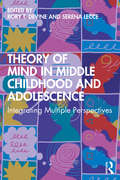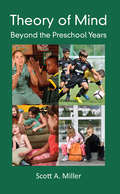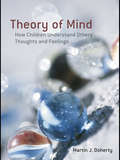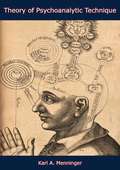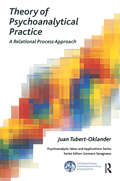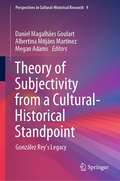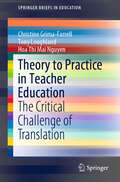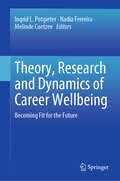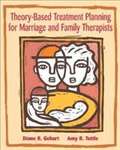- Table View
- List View
Theory and Practice of Family Therapy and Counseling (Second Edition)
by James Robert BitterThis book is intended for undergraduate and graduate students interested in the fields of family therapy and family counselling. It surveys the major theories and practices of contemporary family systems and seeks to support the development of personal, professional, and ethical family practice.
Theory and Practice of Focusing-Oriented Psychotherapy: Beyond the Talking Cure
by John Amodeo Lynn Preston Judy Moore Helene Brenner Laury Rappaport Greg Madison Eugene Gendlin Akira Ikemi Pavlos Zarogiannis Sergio Lara Christiane Geiser Anna Karali Rob Parker Campbell Purton Atsmaout Perlstein Larry Letich Kevin Krycka Annmarie Early Zack Boukydis Bala Jaison Peter AffordThis comprehensive introduction to Focusing-Oriented Psychotherapy lays out the background and fundamentals of the approach covering theory and practice. Gendlin, after many articles on Focusing-oriented psychotherapy, finally published the text Focusing-Oriented Psychotherapy in 1996, making these ideas more widely available to the world. With contributions from some of the world's most influential contemporary Focusing-Oriented Psychotherapists and a foreword by Gendlin, this book provides a long overdue survey of this growing field. It explores how Focusing has been integrated with other theoretical orientations such as attachment theory, solution focused therapy, relational psychoanalysis, and existential therapy. Contemporary issues in Focusing-Oriented Psychotherapy are also covered, such as its suitability across cultures, and how it relates to the latest findings in the field of neuroscience. The book is essential reading for all practicing therapists and counselors, as well as trainee therapists, particularly those who want to explore the potential of experiential dimensions in their therapy and coaching practice. Jessica Kingsley Publishers also publishes a companion volume, Emerging Practice in Focusing-Oriented Psychotherapy: Innovative Theory and Applications, edited by Greg Madison [9781849053716].
Theory and Practice of Group Counseling
by Gerald CoreyThis text outlines the basic elements of group process, deals with ethical and professional issues of group work, and overviews the key concepts and techniques of ten approaches to group counseling. This updated sixth edition emphasizes the practical applications of the theoretical models of group work, and encourages students to develop a synthesis of these approaches. There are two new chapters on stages of group development. Corey is professor emeritus of human services at California State University.
Theory and Practice of Group Counseling
by Gerald CoreyGain an in-depth overview of the ten group counseling theories with Corey's best-selling THEORY AND PRACTICE OF GROUP COUNSELING, 10E. Using a clear, straightforward writing style, this edition illustrates how to put these theories into practice and even guides you in developing your own framework for effective group counseling with a syntheses of various aspects of the theories. New learning objectives and a consistent chapter structure help you easily grasp each theoretical concept and its relationship to group practice. This edition highlights the latest developments and most recent literature from the field with new and expanded information on accreditations, ethics and cultural sensitivity. A new video series, Group Theories in Action, provides video segments that correspond to Chapters 6-15 and bring each theory to life.
Theory and Practice of Group Counseling (8th Edition)
by Gerald CoreyWith the guidance of world-renowned counseling author, teacher, and practitioner Gerald Corey, best-selling Theory and Practice of Group Counseling, 8e equips readers with the knowledge and skills for effective group counseling and leadership. You'll learn key theoretical approaches to group leadership and how to successfully apply each in practice. With Corey's clear, straightforward writing style, you will have no difficulty understanding each theoretical concept and its relationship to group practice. And as you explore different approaches, your growing knowledge will enable you to integrate techniques from the various approaches you'll study in this book to create a unique approach that works successfully for YOU.
Theory and Practice of Group Counseling (Ninth Edition)
by Gerald CoreyTHEORY AND PRACTICE OF GROUP COUNSELING, 9th Edition, gives readers an in-depth overview of the eleven group counseling theories. In addition to illustrating how to put these theories into practice, this best-selling book guides readers in developing their own syntheses of various aspects of the theories. With Corey's clear, straightforward writing style, readers are able to grasp each theoretical concept and its relationship to group practice with ease.
Theory and Practice of Lesson Study in Mathematics: An International Perspective (Advances in Mathematics Education)
by Rongjin Huang João Pedro da Ponte Akihiko TakahashiThis book brings together and builds on the current research efforts on adaptation, conceptualization, and theorization of Lesson Study (LS). It synthesizes and illustrates major perspectives for theorizing LS and enriches the conceptualization of LS by interpreting the activity as it is used in Japan and China from historical and cultural perspectives. Presenting the practices and theories of LS with practicing teachers and prospective teachers in more than 10 countries, it enables the reader to take a comparative perspective. Finally, the book presents and discusses studies on key aspects of LS such as lesson planning, post-lesson discussion, guiding theories, connection between research and practice, and upscaling.Lesson Study, which has originated in Asia as a powerful effective professional development model, has spread globally. Although the positive effects of lesson study on teacher learning, student learning, and curriculum reforms have been widely documented, conceptualization of and research on LS have just begun to emerge. This book, including 38 chapters contributed by 90 scholars from 21 countries, presents a truly international collaboration on research on and adaptation of LS, and significantly advances the development of knowledge about this process.Chapter 15: "How Variance and Invariance Can Inform Teachers’ Enactment of Mathematics Lessons" of this book is available open access under a CC BY 4.0 license at link.springer.comTheory and Practice of Lesson Study in Mathematics: An International Perspective shows that the power of Lesson Study to transform the role of teachers in classroom research cannot be explained by a simple replication model. Here we see Lesson Study being successful internationally when its key principles and practices are taken seriously and are adapted to meet local issues and challenges. (Max Stephens, Senior research fellow at The University of Melbourne)It works. Instruction improves, learning improves. Wide scale? Enduring? Deep impact? Lesson study has it. When something works as well as lesson study does, while alternative systems for improving instruction fail, or only succeed on small scale or evaporate as quickly as they show promise, it is time to understand how and why lesson study works. This volume brings the research on lesson study together from around the world. Here is what we already know and here is the way forward for research and practice informed by research. It is time to wake up and pay attention to what has worked so well, on wide scale for so long.(Phil Dara, A leading author of the Common Core State Standards of Mathematics in the U.S.)
Theory and Practice of Online Therapy: Internet-delivered Interventions for Individuals, Groups, Families, and Organizations
by Haim Weinberg Arnon RolnickThis innovative new resource outlines the process of conducting individual, family and group therapy online with the use of video conferencing tools, and explores the unique concerns associated with this increasingly popular and convenient approach to treatment. Offering mental health practitioners a definitive presentation on how to use online tools to facilitate psychological intervention, the book will also enable readers to learn about the processes of virtual individual, couple, family and group therapy, specific concerns related to online group dynamics, as well as the responsibilities of the therapist and group leader in online sessions. This is the perfect companion for counselors of all backgrounds and disciplines who are interested in offering or improving their approach to virtual services.
Theory and Treatment Planning in Counseling and Psychotherapy, Second Edition
by Diane R. GehartThe second edition introduces contemporary counseling theories, enabling the readers to skillfully apply theory in real-world settings by introducing theory-specific approaches to case conceptualization and treatment planning. The book can be used as a clinical reference manual to assist mental health professionals in their practice settings for years to come as a helpful aid for conceptualizing treatment with a wide range of clients, writing treatment plans, and preparing for licensing exams.
Theory and Treatment Planning in Family Therapy: A Competency-Based Approach
by Diane R. GehartTHEORY AND TREATMENT PLANNING IN FAMILY THERAPY: A COMPETENCY-BASED APPROACH prepares readers for the realities of practicing therapy. This book's outcomes-based approach engages readers in an active learning process, introducing family therapy theories using theory-specific case conceptualization and treatment planning. These assignments empower readers to apply theoretical concepts and develop real-world skills as early as possible in their training. The author uses a down-to-earth style to explain concepts in clear and practical language. She also includes extensive discussions about how diversity issues and research inform contemporary practice of family therapy.
Theory and Treatment of Anorexia Nervosa and Bulimia: Biomedical Sociocultural & Psychological Perspectives
by Rev Steven Wiley EmmettThis impressive book presents contributions from leading researchers and practitioners in the field of eating disorders and offers a remarkably comprehensive study of the theory and treatment of both anorexia nervosa and bulimia from biomedical, sociocultural and psychological perspectives. Theory and Treatment of Anorexia Nervosa and Bulimia is testimony to the multidetermined nature of the current epidemic of food-related disorders; as such, it emphasizes the pressing need for professionals to collaborate on research and treatment.
Theory of Addiction
by Jamie Brown Robert WestThe word 'addiction' these days is used to refer to a chronic condition where there is anunhealthily powerful motivation to engage in a particular behaviour. This can be driven bymany different factors - physiological, psychological, environmental and social. If we say that itis all about X, we miss V, W, Y and Z. So, some people think addicts are using drugs to escapefrom unhappy lives, feelings of anxiety and so on; many are. Some people think drugs becomeaddictive because they alter the brain chemistry to create powerful urges; that is often true.Others think that drug taking is about seeking after pleasure; often it is. Some take the view thataddiction is a choice - addicts weigh up the pros and cons of doing what they do and decidethe former outweigh the latter. Yet others believe that addicts suffer from poor impulse control;that is often true... And so it goes on.When you look at the evidence, you see that all these positions capture important aspects ofthe problem - but they are not complete explanations. Neuroscience can help us delve moredeeply into some of these explanations, while the behavioural and social sciences are better atexploring others. We need a model that puts all this together in a way that can help us decidewhat to do in different cases. Should we prescribe a drug, give the person some 'tender lovingcare', put them in prison or what? Theory of Addiction provides this synthesis.The first edition was well received:'Throughout the book the reader is exposed to a vast number of useful observations...Thetheoretical aims are timely, refreshing, ambitious and above all challenging. It opens up a newway of looking at addiction and has the potential to move the field of addiction a considerableleap forward. Thus we wholeheartedly would like to recommend the book for students as wellas scholars. Read and learn!' Nordic Studies on Alcohol and Drugs'The book provides a comprehensive review of existing theories - over 30 in all - and thissynthesis of theories constitutes an important contribution in and of itself... West is to becommended for his synthesis of addiction theories that span neurobiology, psychology andsocial science and for his insights into what remains unexplained.' AddictionThis new edition of Theory of Addiction builds on the first, including additional theories inthe field, a more developed specification of PRIME theory and analysis of the expandingevidence base.With this important new information, Theory of Addiction will continue to be essential readingfor all those working in addiction, from student to experienced practitioner - as urged above,Read and learn!
Theory of Mind
by Hans FörstlTheory of Mind ist die Grundlage allen sozialen und "sittlichen" Verhaltens. Rücksicht, Respekt und Mitgefühl kann nur entwickeln, wer Interesse am anderen hat, ein Gefühl für dessen Bedürfnisse und ein differenziertes Verständnis seiner Perspektiven. Störungen der Theory of Mind führen zu erheblichen Defiziten in der sozialen Interaktion; im vorliegenden Buch werden viele Beispiele dafür genannt. Für die 2. Auflage wurden die Kapitel aktualisiert und bearbeitet. Neu in dieser Ausgabe: - Mentalizing aus soziologischer Sicht - Neuronale Grundlagen - Rehabilitation
Theory of Mind Development in Context
by Virginia Slaughter Marc De RosnayTheory of Mind Development in Context is the first book of its kind to explore how children’s environments shape their theory of mind and, in turn, their ability to interact effectively with others. Based on world-leading research, and inspired by the ground-breaking work of Candida Peterson, the original collected chapters demonstrate that children’s understanding of other people is shaped by their everyday environment. Specifically, the chapters illustrate how theory of mind development varies with broad cultural context, socioeconomic status, institutional versus home rearing, family size, parental communication style, and aspects of schooling. The volume also features research showing that, by virtue of their condition, children who are deaf or who have an autism spectrum disorder function in environments that differ from those of typical children and this in turn influences their theory of mind. Although much important research has emphasized the role of nature in theory of mind development, this book highlights that children’s understanding of other people is nurtured through their everyday experiences and interactions. This perspective is essential for students, researchers, and practitioners to gain a complete understanding of how this fundamental skill develops in humans. The book is invaluable for academic researchers and advanced students in developmental psychology, education, social psychology, cognitive psychology, and the social sciences, as well as practicing psychologists, counselors, and psychiatrists, particularly those who deal with disorders involving social and/or communicative deficits.
Theory of Mind and the Triad of Perspectives on Autism and Asperger Syndrome: A View from the Bridge
by Olga BogdashinaInspired by the often uncomfortable interplay between autistic individuals, parents and professionals in understanding autistic spectrum conditions, Olga Bogdashina uses the concept of Theory of Mind (ToM) to consider these groups' different (and often conflicting) perspectives. ToM is the ability to imagine and make judgements about what others feel and think; its absence in autistic individuals is called 'mindblindness'. This book addresses the 'mindblindness' of people united in their interest in autism but divided by their different angles and perspectives. Divided into four parts, the book first defines autism, then the views of the three main groups working with it - autistic individuals, parents and professionals - under the headings of classifications, diagnosis, causes, development, theories and treatment. By comparing and reconciling the different perspectives in this way, the book helps each group to understand and predict each other's responses and behaviours. This enlightening and innovative book offers a unique way of 'stepping in each other's shoes' and is a valuable resource for all people living or working with autism.
Theory of Mind in Childhood (Elements in Child Development)
by Diane Poulin-DuboisThis Element describes the development of a Theory of Mind, or mentalizing, in infancy and early childhood. Theory of Mind is a key social cognitive ability that permits children to predict and explain human behaviors by attributing mental states to other people. Understanding mental states gradually progresses from basic desires to false beliefs. The Element reviews the proximal and distal cognitive and social determinants that facilitate early Theory of Mind development. Discoveries in neuroscience contribute to understanding the ontogeny of Theory of Mind. This Element presents an overview of the main theoretical accounts of Theory of Mind development and offers suggestions for future research.
Theory of Mind in Middle Childhood and Adolescence: Integrating Multiple Perspectives
by Rory T. Devine and Serena LecceThis landmark text integrates diverse perspectives on how humans understand others’ minds (or ‘theory of mind’) beyond early childhood into middle childhood and adolescence. It explores how the neural, cognitive, and social changes of middle childhood and adolescence shape the ongoing development of theory of mind, and how theory of mind helps children navigate their lives. Drawing on cutting-edge research from leading international experts, this book provides a survey and analysis of the current state and future direction of the field. It is organized around three themes relating to the key issues in contemporary research. The first part focuses on the biological and cognitive bases of theory of mind in middle childhood and adolescence. The second part goes on to explore the social predictors and consequences, considering how theory of mind is shaped by social experiences and, in turn, impacts children’s social lives in middle childhood and adolescence. Finally, the third part focuses on theory of mind in the context of neurodiversity, disability, and youth mental health in middle childhood and adolescence. Offering in-depth understanding for all students and scholars of developmental and cognitive psychology, neuroscience, clinical psychology and psychiatry, and education, this valuable text also identifies an agenda for future scholarship on this exciting topic.
Theory of Mind: Beyond the Preschool Years
by Scott A. MillerThis is the first book to provide a comprehensive review of the burgeoning literature on theory of mind (TOM) after the preschool years and the first to integrate this literature with other approaches to the study of social understanding. By highlighting the relationship between early and later developments, the book provides readers with a greater understanding of what we know and what we still need to know about higher-order TOM. Although the focus is on development in typical populations, development in individuals with autism and in older adults is also explored to give readers a deeper understanding of possible problems in development. Examining the later developments of TOM gives readers a greater understanding of: Developments that occur after the age of 5. Individual differences in rate of development and atypical development and the effects of those differences. The differences in rate of mastery which become more marked, and therefore more informative, with increased age. What it means to have a “good theory of mind.” The differences between first- and second- order theory of mind development in preschoolers, older children, adolescents, and adults. The range of beliefs available to children at various ages, providing a fuller picture of what is meant by “understanding of belief.” After the introduction, the literature on first-order developments during the preschool period is summarized to serve as a backdrop for understanding more advanced developments. Chapter 3 is devoted to the second-order false belief task. Chapters 4 and 5 introduce a variety of other measures for understanding higher-level forms of TOM thereby providing readers with greater insight into other cognitive and social developmental outcomes. Chapter 6 discusses the relation between children’s TOM abilities and other aspects of their development. Chapters 7 and 8 place the work in a historical context. First, the research on the development of social and mental worlds that predated the emergence of TOM is examined. Chapter 8 then provides a comparative treatment of the two literatures and how they complement one another. Ideal as a supplement in graduate or advanced undergraduate courses in theory of mind, cognitive development, or social development taught in psychology and education. Veteran researchers will also appreciate this book‘s unique synthesis of this critical research.
Theory of Mind: How Children Understand Others' Thoughts and Feelings (International Texts in Developmental Psychology)
by Martin DohertyMost of us are continually aware that others have thoughts and feelings – but are children? When? This book is a concise and readable review of the extensive research into children’s understanding of what other people think and feel, a central topic in developmental psychology known as "Theory of Mind". The understanding of belief is central to this text, which explains in simple terms what representational theory of mind is all about, and shows how researchers have demonstrated this understanding in 4-year-olds. The book considers what leads to this understanding, including the role of pretend play, understanding of attention and eye direction, and other precursors to representational understanding of mind. The general relevance of theory of mind is demonstrated through coverage of the development of other mental state concepts, and the relationship between understanding mental representation and other representational media. The author also carefully summarizes current research on the relationship between theory of mind and concurrent developments in executive functioning, and the understanding of language. The book closes by considering autism. A major achievement of theory of mind research is the light it has helped throw on this puzzling developmental disorder. Providing a comprehensive overview of 25 years of research into theory of mind, the book will be of great interest to both students and researchers in psychology, philosophy and the cognitive sciences.
Theory of Psychoanalytic Technique
by Karl A. MenningerThis book examines the essential dynamics of the interpersonal situation involved in a two-party contract or—to use the word preferred by Dr. Maxwell Gitelson—compact. The author applies these dynamic principles to the psychoanalytic treatment situation, pointing out the pressures and values which can be mobilized to favor communication by the patient to the listening therapist and the extent to which these are followed by gratifications and frustrations which alter the balance in such a way as to determine a progressive course. If the reader will note the topics of the chapters listed he will observe that the reactions of both patient and therapist to each other in the interactive process or compact are carried systematically and successively to a point where separation of the contractees is logical. This over-all view will permit us to examine such familiar phenomena as transference, regression, resistance, interpretation, and so on in a perspective which gives them a clearer meaning. It will be objected that this sharpness or clarity involves certain distortions or misrepresentations, dependent upon oversimplification. But this is the perennial dilemma of the teacher: the teaching of facts and figures versus the teaching of truth.—Print ed.
Theory of Psychoanalytical Practice: A Relational Process Approach (The International Psychoanalytical Association Psychoanalytic Ideas and Applications Series)
by Juan Tubert-OklanderThis book makes an original contribution to the study of the psychoanalytic process from a relational point of view, and at the same time serves as a textbook on the theory of technique. It provides a general exposition of the theory of psychoanalytic practice from a process perspective that emphasizes the analytic relationship, the dyadic nature of the psychoanalytic situation, and the impact of unconscious interaction between its two parties, and also includes the authors personal point of view and contributions on the subject.
Theory of Subjectivity from a Cultural-Historical Standpoint: González Rey’s Legacy (Perspectives in Cultural-Historical Research #9)
by Albertina Mitjáns Martínez Daniel Magalhães Goulart Megan AdamsThis book examines key ideas related to the Theory of Subjectivity within a cultural-historical approach. It brings together the intellectual contributions made by Professor Fernando González Rey (1949–2019) towards understanding human subjectivity, and emphasizing their unfolding in different fields and contexts. The book addresses the genesis and development of González Rey’s work, articulating this discussion with the author’s biography. González Rey’s main scientific contribution is the Theory of Subjectivity in a cultural-historical perspective, which is inseparable from Qualitative Epistemology and from its constructive-interpretive methodological expression. The book presents and discusses González Rey’s contributions to different contexts and fields, such as psychological research, education, cultural-historical psychology, human development, motivation, human health and psychotherapy. This book brings together examples of how these ideas have been employed and developed in different fields and contexts.
Theory to Practice in Teacher Education: The Critical Challenge of Translation (SpringerBriefs in Education)
by Christine Grima-Farrell Hoa Thi Nguyen Tony LoughlandThis book offers a theoretically and empirically robust account of what is known about the effective approaches that translate theory to practice in teacher education, presenting evidence from case studies from a diverse range of contexts informed by various methodological foundations. It also provides accounts that support teacher educators involved in both school and university based teacher education.The book offers insights into the translation of theory to practice from the long history of teacher education, the benefit of diverse approaches in terms of the effectiveness of initial teacher education, and the impact of professional standards.
Theory, Research and Dynamics of Career Wellbeing: Becoming Fit for the Future
by Melinde Coetzee Ingrid L. Potgieter Nadia FerreiraThis volume offers a new conceptualization of career wellbeing by viewing the construct as an individual’s long-term contentment with their career outcomes, career achievements, career changes and their sustainable employability amidst the complexities of the contemporary and emerging future digital-driven work environment. In support of this view of career wellbeing, the volume constructs theoretical frameworks for “future-fit” career wellbeing in the digital-driven work–life context. The chapters juxtaposition current research trends in terms of future potential directions for research on career wellbeing in Industry 4.0. The volume also critically evaluates the relevance, applicability and utility of the research findings and theoretical premises in various current versus potential Industry 4.0 settings for individuals across the life-span. It offers valuable suggestions for practice and interventions.
Theory-Based Treatment Planning for Marriage and Family Therapists: Integrating Theory and Practice
by Diane R. Gehart Amy R. TuttleThis text is a treatment planner and theory guide for therapists working from systemic and postmodern approaches. Unlike existing resources, this treatment planner provides a means to directly integrate family therapy theory and practice. By providing treatment planning strategies along with complete overviews of specific theories, the book provides a remedy for the common "missing link" between theory and practice. The purpose of this book is to fill the ever-widening gap between formal training in theory and actual practice in managed-care dominated workplaces. The text covers 11 of the most widely used family therapies providing a summary for each theory and then specific strategies for developing a treatment plan.
